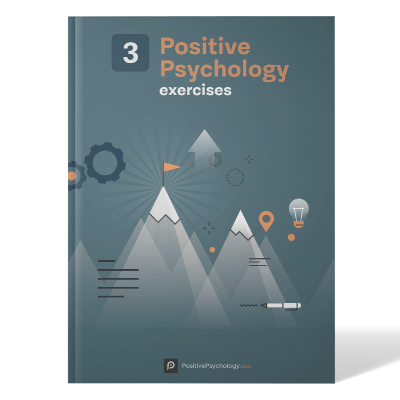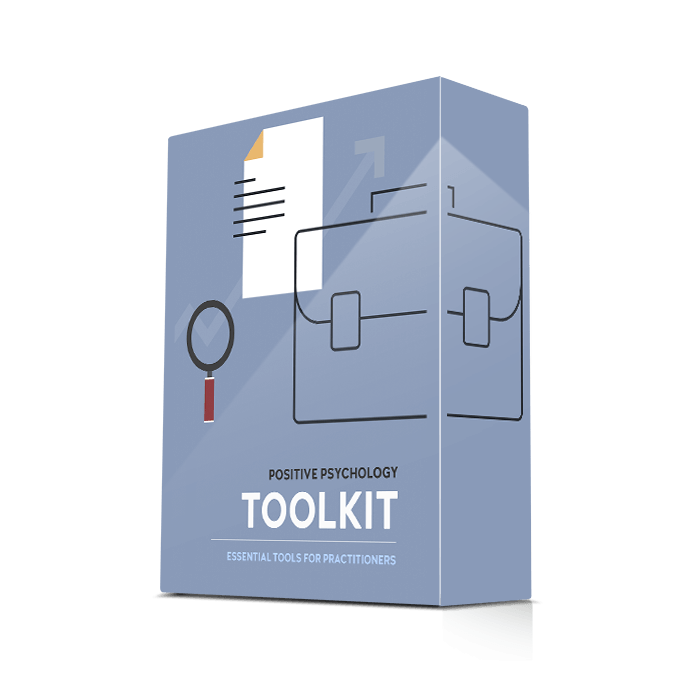

Therapy can be a lifesaving and life-altering choice for individuals and families struggling with mental and emotional health issues.
Unfortunately, 40% to 60% of families end therapeutic treatment prematurely (Thompson et al., 2009).
If clients are not engaged in the treatment process, how can it be effective?
Additionally, traditional talk therapy is often not enough to reach deep-seated problems or promote holistic wellness.
The famous psychotherapist Carl Rogers (1961, p. 67) said,
“Experience is for me, the highest authority.”
His quote illustrates the power of experience and how it might provide an avenue to a deeper level of engagement, truth, and wellbeing in therapy.
In this article, we will focus on experiential therapy forms and how they can help clients achieve their personal goals.
Before you continue, we thought you might like to download our three Positive Psychology Exercises for free. These science-based exercises explore fundamental aspects of positive psychology, including strengths, values, and self-compassion, and will give you the tools to enhance the wellbeing of your clients, students, or employees.
Experiential therapy is a type of therapy that uses expressive activities and tools to help clients re-experience emotional situations from their past or from past/present relationships (Greenberg et al., 1998).
Recreating authentic experiences allows feelings, beliefs, and attitudes beneath the conscious mind to come into awareness. Experiential therapy is not one type of intervention, but a variety of different interventions focusing on experiences, emotional processes, interactions with others, creativity, and reflections of events. (Greenberg et al., 1989).
Experiential therapy refers to a therapy that brings clients into the experience instead of simply talking about the experience. Clients can process from the inside out and embody things they need to work through rather than discussing them from an outside, analytical perspective (Greenberg et al., 1998).
For this reason, experiential therapies can be very useful when talk therapy is not helpful.
There are a variety of different therapeutic approaches that can be considered experiential therapy, including Gestalt therapy and dynamic therapy. Rooted in a humanistic paradigm from Abraham Maslow’s hierarchy of needs and the client-centered approach of Carl Rogers, experiential therapy helps clients develop insight and realize inner thoughts, feelings, and experiences to find wholeness and healing (Greenberg et al., 1998).
The theory behind it suggests that humans are “potentials of experiencing” (Greenberg et al., 1998, p. 95) and that this experience can lead to change.
As such, there are different examples of experiential therapy. These include, but are not limited to, adventure/nature therapy, equine/animal therapy, expressive therapy, psychodrama, and body-centered therapies.
Science has demonstrated numerous mental health benefits of experiencing nature, including decreases in anxiety, stress, and depression and an increase in happiness (Meredith et al., 2020).
Nature therapy is also known as ecotherapy and is based on the concept of using nature to help heal. In these types of therapies, the client is formally guided by trained leaders such as wilderness guides and park rangers to experience and appreciate aspects of nature and our physical connection to it.
Clients often find it easier to make a personal connection with a nonjudgmental animal. Equine therapy involves both riding horses and feeding and grooming them. It provides physical movement and connection that can help with many ailments such as anxiety, depression, and trauma (Schertz & Berman, 2019).
Other animals such as cats and dogs are often used in animal therapy to help clients gain empathy and independence, increase impulse control, and improve stress tolerance.
Expressive arts therapy includes things like drawing, painting, crafting, and pottery. Creating artwork allows clients to release emotions in the moment without judgment because art is subjective. There is no right or wrong.
In this way, it is a great way to reduce shame, increase empowerment and self-awareness, reduce stress, and resolve emotional conflict (Mahrer, 2001).
Psychodrama therapy includes role-play in individual, family, or group sessions. In drama therapy, props are often used to develop characters. Clients can become the leading role in their own narrative, watch themself engage in a mirror, reverse roles, or play back specific life experiences.
It allows them to gain a different perspective, learn communication, and improve social skills (Mahrer, 2001).
Body-centered therapies include yoga therapy, dance therapy, and breathwork. Moving the body gets clients out of their head and able to process emotions.
Body movement is particularly helpful for accessing trauma and difficult feelings stored in the body. Somatic work provides the space for deep healing that may lie in the subconscious.

Experiential therapy is based on two core components.
The first is an emphasis on the therapeutic relationship, which helps facilitate change for the client. The second is that clients have an experience that allows them to examine inner world views, feelings, perceptions, values, and beliefs (Greenberg et al., 1998).
The distinction between the relational conditions and working conditions of experiential therapy make it a unique bottom-up approach to healing. Experiential therapy emphasizes the role of emotion in personal development and general functioning (Greenberg et al., 1998).
When clients realize these emotions and integrate them with cognitive systems, they can become more satisfied with their environment and more accepting of themselves.

Enhance wellbeing with these free, science-based exercises that draw on the latest insights from positive psychology.
Download PDF
By filling out your name and email address below.
There are some key concepts of experiential therapy that set it apart from traditional talk therapy.
Experiential therapy works with the mind (cognition), body (somatic), and emotions. These three things interact in complex ways. Experiential therapy emphasizes the bottom-up approach to focus on physical sensations, raw data from the body, and the emotional responses to these (Elliot et al., 2013). This differs from the logical understanding of “facts” that traditional talk therapy addresses.
Neurobiology is a foundational concept of experiential therapy. Experiential therapists understand and use neurobiological processes to facilitate deep levels of change (Elliot et al., 2013).
They operate from an understanding of how the automatic emotional and physical responses work and how to rewire these automatic responses.
Experiential therapy is particularly effective at resolving dissonance between what one thinks rationally and what is felt on a deeper level (Elliot et al., 2013). For example, if someone knows rationally that it is necessary and healthy to set boundaries, but feels that it is wrong or unsafe on an emotional level, their thoughts and beliefs will not match their behaviors.
Using a strong therapeutic alliance, practitioners help clients bridge the gap between the mind and the body using some form of experiential technique.

Experiential therapy includes a range of therapeutic interventions that help clients connect with inner experiences and the present moment and embody emotional experiences.
Some of the most well known are humanistic experiential therapy, experiential family therapy, experiential dynamic therapy, and experiential play therapy.
Humanistic therapies are based on the foundational belief that people are good and emphasize helping clients reach their full potential (Elliot & Greenberg, 2007).
Using experiential techniques, humanistic experiential therapy is focused on the whole person rather than specific “problems.” Humanistic experiential therapy uses a holistic approach to focus on free will, human potential, and self-discovery.
Experiential family therapy uses active, multisensory techniques such as role-play and drawing to increase a family’s ability to express affect. Increasing affect and uncovering information can stimulate change and growth within the family system (Bischof, 2016).
It is a form of family therapy that uses active, multisensory techniques such as role-play, interactive drawing, and outdoor experiences.
Experiential dynamic therapies involve psychodynamic, experiential, relational, and transformation-oriented characteristics (Pascual-Leone & Greenberg, 2007).
They are built on aspects of Freudian psychoanalytic theory by working with unconscious forces but emphasize the importance of experiencing rather than avoiding emotions during sessions.
Experiential dynamic therapy attempts to help clients achieve change rapidly through use of the therapeutic relationship.
Play therapy is experiential in nature and designed for younger clients, typically under the age of 12. The goal of experiential play therapy is to help children gain empowerment over negative emotions by reframing distressful experiences (Norton & Norton, 2006).
Various forms of play, from dress-up to the use of toys, help children move through five basic stages. These stages include the exploratory stage, testing for protection stage, dependency stage, therapeutic growth stage/integration of self, and the termination stage (Norton & Norton, 2006).

The Positive Psychology Toolkit© is a groundbreaking practitioner resource containing over 500 science-based exercises, activities, interventions, questionnaires, and assessments created by experts using the latest positive psychology research.
Updated monthly. 100% Science-based.
“The best positive psychology resource out there!”
— Emiliya Zhivotovskaya, Flourishing Center CEO
Experiential therapy can be used to treat a wide range of psychiatric disorders and challenges. Experiential methods have been used to treat trauma, eating disorders, addictive behaviors, anger, grief, and loss (Mahrer, 2001).
It can also be a helpful form of therapy for individuals who deal with painful and distressful experiences from the past or desire to improve current and future relationships.
As mentioned previously, the first step in any form of experiential therapy is to develop a strong therapeutic alliance (Elliot et al., 2013). This makes it particularly important to find a professional who has additional training in specific forms of experiential therapy.
Once a strong alliance is formed, clients are taught to reflect on experiences, confront situations or troubling memories, and resolve internal conflict through a variety of techniques.
Experiential therapy can be offered in individual, group, clinical, and medical settings (both in and outpatient). It is commonly performed in conjunction with traditional talk therapy (Richard et al., 2022).
Experiential techniques will focus on some subjective experience, such as sensations, perceptions, and affective states, which helps pull the client into the “here and now.” Through this, clients can begin the process of self-reflection and internal awareness.
There are a vast number of experiential techniques that can be implemented into therapy sessions.
Music therapy has demonstrated emotional, physical, and neurological benefits for a variety of conditions.
According to Drury University, there are four types of music therapy.
Art can be an easily accessible way to implement expressive techniques into session. Clients can draw or paint with the freedom to express subconscious emotions. It is thought that creating art is a foundational way of expressing our deepest thoughts, feelings, and emotions when words are not enough (Mahrer, 2001).
Creating art, whether through drawing or other forms of creative expression, allows clients to explore the internal parts of themselves. A qualified art therapist can help the client interpret the what and how of the creative process to develop understanding and healing.
Mindful practices help clients come into the present moment and develop a sense of “what is” without judgment or expectation (Ludwig & Kabat-Zinn, 2008). The internal awareness created through mindfulness is an avenue to radical acceptance and healing.
Mindful practices can include: